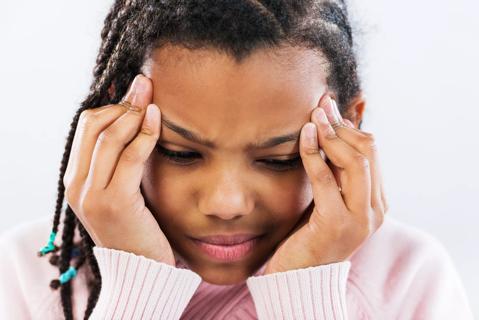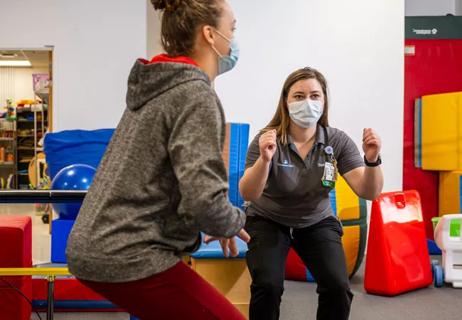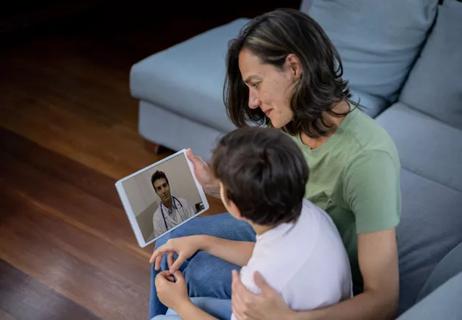Two cases highlight the importance of differentiating lower extremity pain

It’s important to maintain a broad differential when distinguishing benign leg pains, like those of “growing pains” or overuse from sports, from a more serious pathology.
Cleveland Clinic is a non-profit academic medical center. Advertising on our site helps support our mission. We do not endorse non-Cleveland Clinic products or services. Policy
The term “growing pains” was coined nearly a century ago to describe generalized, typically bilateral extremity pain in children. While the etiology is not well-understood, patients usually report that pain resolves with little to no medical intervention. Also referred to as recurrent limb pains in childhood and idiopathic nocturnal pains of childhood, growing pains may affect as many as 37% of children ages 3 to 12, according to some studies. Yet, they remain largely unexplainable, notes Lainie Holman, MD, Chair of Pediatric Physical Medicine and Rehabilitation at Cleveland Clinic Children’s Hospital for Rehabilitation (CCCHR).
Dr. Holman explains that growing pains have been investigated from a variety of medical frameworks — from biomechanical and musculoskeletal fatigue to hypovitaminosis, vascular insufficiency and psychosomatic syndromes.
“These studies have all been smaller, and there is no one prevailing theory that fully explains why some children experience growing pains and some don’t when they’re all growing,” says Dr. Holman. “It could be that the pain represents a pain amplification syndrome, similar to fibromyalgia in adults, but because it’s benign and often resolves without intervention, management is more focused on rest, modifications, and monitoring,” she explains.
Other causes of benign leg pain in children may be related to apophysitis, osteochondritis, Os trigonum syndrome, and avulsion fractures. A detailed history and appropriate imaging are essential to diagnose the condition and counsel patients.
“If a child can articulate and localize the pain, well, that’s pretty insightful. That should tell us something,” says Dr. Holman.
In a recent case, an 11-year-old patient presented to Cleveland Clinic’s North Olmsted Family Health Center, reporting 20 months of bilateral heel pain. The patient had previously been diagnosed with calcaneal apophysitis (Sever’s disease) by their primary care provider.
The patient, an ice hockey player, located the pain in the posterior, distal heel, but not exactly at the Achilles’ insertion. It was worse in the left heel, particularly with left great toe flexion and plantarflexion, and with no difference in pain when ascending versus descending stairs or going uphill versus downhill. It was worse after brief rests and did not hurt at night.
The child was prescribed Naprosyn, counseled on the use of a heel cup, stretching and immobilization. The child’s pain persisted after several weeks, and the team suspected another syndrome may be at hand.
Given the patient’s history and physical exam, Dr. Holman concluded that the pain was likely a result of repetitive stress, seen frequently in sports such as ice hockey, in the setting of an accessory bone, also known as Os trigonum syndrome. The team used magnetic resonance imaging (MRI) short-TI inversion recovery (STIR), which confirmed the diagnosis.
“Os trigonum is a bone that develops behind the ankle. Not everyone has one, and the people who do, don’t necessarily experience pain,” she says.
Management is usually focused on a patient-specific combination of rest, immobilization, ice packs, and nonsteroidal anti-inflammatory drugs to treat the pain.
Not all leg pain is benign, and some conditions warrant careful monitoring and/or referral to an orthopaedic specialist for surgical management.
Slipped capital femoral epiphysis (SCFE), characterized by the femoral head slipping off the neck of the bone, results in unilateral hip or thigh pain and requires surgical intervention. Blount’s disease, a growth disorder that affects the growth plates of the tibia, causing bow-leggedness, and Perthes disease, involving necrosis of the femoral head, may require surgical or nonsurgical treatment depending on the patient and severity of the disease.
Dr. Holman cautions to take these clinical suspicions seriously. “Some of these patients may have knee or thigh pain that isn’t obvious on a knee X-ray. Unexplained knee or thigh pain should prompt a hip exam and possibly imaging of the hip,” cautions Dr. Holman.
Leg pain in children may also be tied to trauma, sickle cell disease, cancer, rickets, juvenile idiopathic arthritis, or infection.
When a 7-year-old who had twisted his left ankle presented to Cleveland Clinic, no acute abnormality was detected on the radiograph, although, bone mineralization appeared to be slightly decreased. No other pain, fever or weight loss was observed.
A week later, the child presented again; this time with right ankle pain. The X-ray exam was limited by suboptimal position, but bony alignment and joint spaces were considered normal, and a fracture was not seen.
Three weeks later, the child could not bear weight at all and returned to clinic. Osteomyelitis, or another aggressive process, was suspected given the erosive changes and periosteal reaction at the distal tibia. The child was admitted for an MRI to rule out osteomyelitis. Surprisingly, following the MRI, a bone biopsy revealed B-cell acute lymphoblastic leukemia.
Dr. Holman says this is a good reminder of the importance of careful assessment of imaging, which may be overlooked in a busy, primary care pediatric practice.
“Any sort of erosive bone density at that age, in a kid who is otherwise active and healthy, is not a typical finding,” she says.
Lower extremity pain in children can be straightforward and benign or more complex with underlying pathology.
“For these issues and more, our care teams in CCCHR’s outpatient program are skilled in diagnosing and managing non-operative musculoskeletal conditions, sports injuries, and gait abnormalities,” Dr. Holman concludes.


Self-efficacy mindset, burst therapy and increased biofeedback may help improve outcomes

6 objective measures to assess pain and evaluate progress

Recognizing mobility as a human right is instrumental to change

A closer look at select programs and services

Physicians in the field should tout an array of accomplishments to achieve well-deserved recognition

How lyric writing, song production is helping patients ‘reclaim their power’

Barriers to access and innovations on the horizon